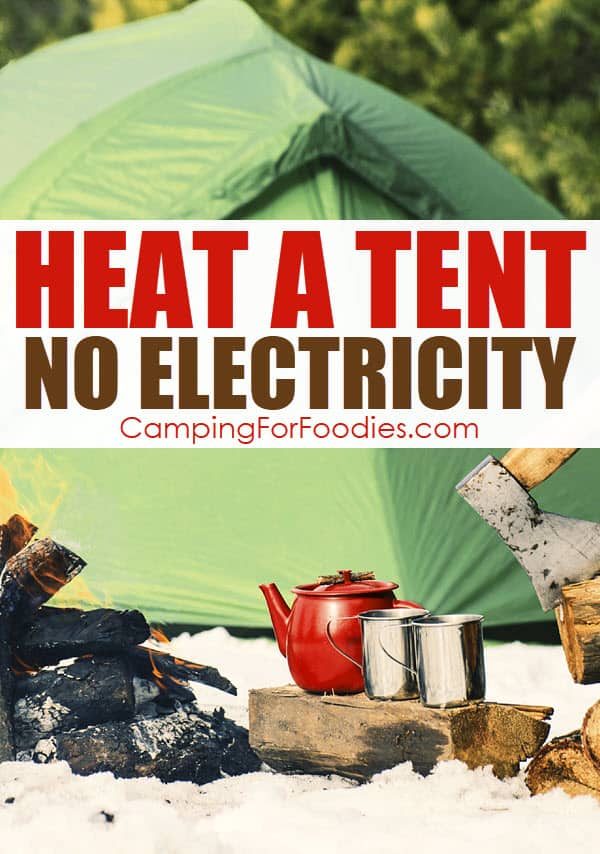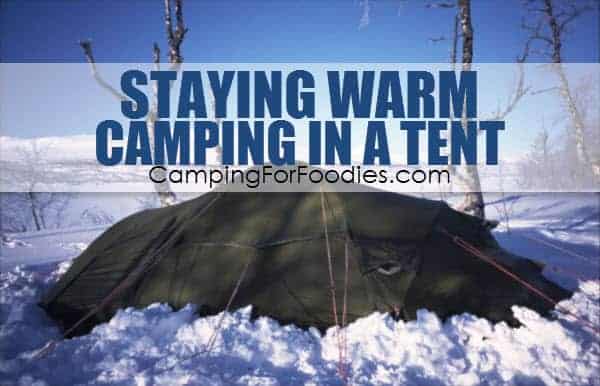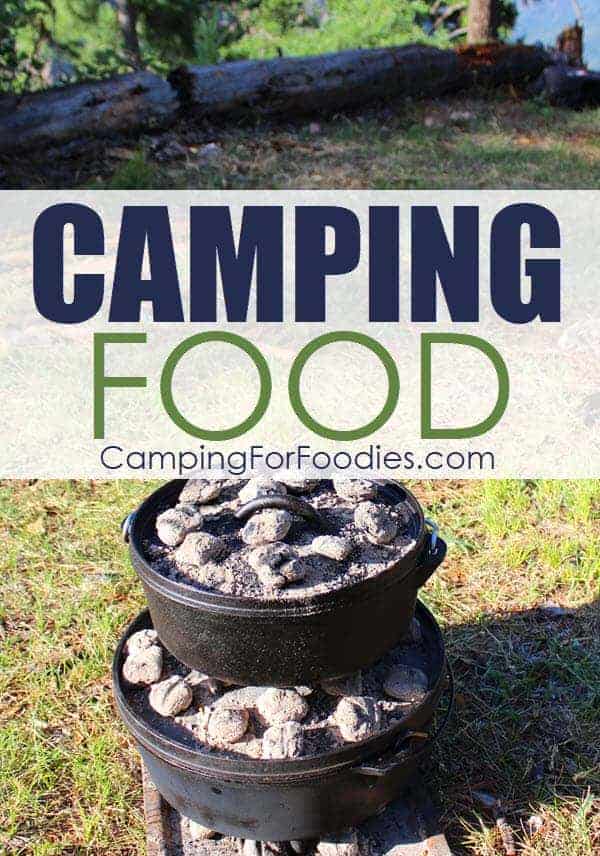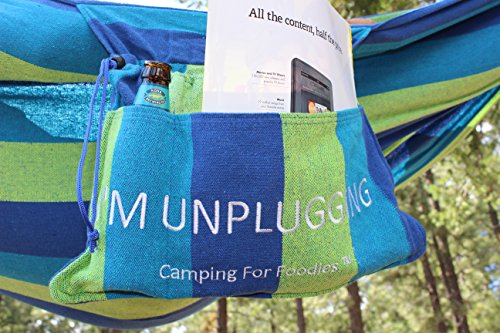Some of the most common camping tips requested by tent campers have to do with managing unfavorable weather.
If you know how to heat a tent without electricity, your cold weather camp trips will be much more enjoyable.

Psst we’re compensated…see our disclosures.
Safety First
Let me start by saying every method of heating a tent has the potential to be very dangerous including fire hazards, carbon monoxide poisoning etc.
If the chemical reactions that turn fuel into heat are disrupted, you could have dangerous results. Carbon dioxide is produced during complete combustion, but, if there is not enough oxygen in the air (like inside an unventilated tent or RV), carbon monoxide is produced which is a colorless, odorless and deadly gas.
You can see why carbon monoxide is also referred to as the “silent killer”. So, please be careful, exercise common sense, take safety precautions, do research and follow the manufacturer’s instructions anytime you are heating-up your tent.
Best Tents For Cold Nights And Cold Ground
When you are trying to heat a tent in cold air, the first thing you want to do is start with a warm tent.
You can generate all the heat you want … but … if it just gets lost through the structure of a non-insulated tent, you are fighting a losing battle.
4-Season Tents
Using 4-season tents that are specifically designed to withstand cold weather camping trips is the best option.
The Naturehike Cloud-Up, for example, has features that are compatible with winter camping including:
- Snowskirt: To keep the ground under the tent dry by diverting rain and snow away from it.
- Double layers: Inner and outer tent layers used together as a waterproof and windproof tent in cold temperatures and use only the inner layer for a more ventilated tent when camping in warm air months.
- Waterproof materials: 20D Rip-Stop Nylon, Polyester with PU 4000 coating.
Naturehike Cloud-Up 3 Person Lightweight Backpacking Tent with Footprint with Snow Skirt – 4 Season Free Standing Tent Ultralight 20D Silicone Coated Waterproof Backpack Camping Tent
Summer Season Tents
If your tent is not designed for harsh wintry weather, there are different ways you can add insulation to it.
- Ground-Based Tarps: Place a heavy waterproof tarp on the ground beneath the tent to create an extra barrier between your tent floor and wet/cold ground. Keeping your tent floor dry is the goal.
- External Coverings: Use additional heavy waterproof tarps to cover the outside of the tent. You are trying to mimic the outer tent layer of a 4-season tent. Your goal is to block wind and rain by covering the whole tent including the roof, walls, doors and windows.
Mylar Blanket Facts
A Mylar blanket DOES NOT provide insulation, it DOES reflect heat. It is also waterproof and windproof.
When radiant heat from an external heat source hits a Mylar blanket’s shiny surface, it bounces off from it. An object that is producing heat (like your body heat) can use a Mylar blanket to either reflect heat away from the object or back toward it. A great way to use this type of blanket in a summer-season tent is to use it in conjunction with wool camp blankets because of their insulating properties.
So, instead of using a Mylar blanket to attach to your tent, you would use it around your body, wrapping in this order:
- Your body (being the heat generator)
- A wool blanket (being the insulator)
- A Mylar blanket (being the reflector, bouncing the heat back to you)
Types Of Portable Heaters Used In Tents
The most common energy sources used for heating tents:
- Propane heaters (using 1 pound propane bottles or larger tanks)
- Gas heaters (using gasoline and diesel)
- Electric heaters (using battery packs, 12-volt cigarette lighter styles and 110 volt wall plugs)
Mr. Heater Buddy 4,000-9,000-BTU Indoor-Safe Portable Propane Radiant Heater
The Mr. Heater does not require any electricity to operate which is why it is one of the most popular heaters for camping off-the-grid. It runs on 1 pound propane bottles or can be hooked up to larger tanks with a proper adapter, no battery is required to operate this unit.
It provides immediate heat but you will need to change the 1 pound propane gas canisters in the middle of the night if you are running it on high because it only runs for about 3 hours on the max BTU setting.
This 4,000 – 9,000 BTU radiant heater is great for spaces up to 225 square feet. The warmest position is right in front of the heater. The heat is directional so it does not do a great job of heating the air inside the entire tent.
The heater may shut off when it is operated at altitudes over 7,000 FT above sea level.
This portable gas heater has safety features so it automatically shuts off if…
- the unit tips over,
- the pilot light goes out, or
- if low oxygen levels are detected.
But you also want to have a carbon monoxide alarm any time you are using equipment that has the potential to produce the “silent killer” if there is not enough oxygen inside the tent.
When you burn propane, water vapor is released which can cause condensation to accumulate inside your tent making things wet and cold … which is what you are trying to avoid in the first place. You can see there are pros and cons to this unit.
Mr. Heater F232000 MH9BX Buddy 4,000-9,000-BTU Indoor-Safe Portable Propane Radiant Heater
If you use gear that is powered using 1 lb propane cylinders and are interested in learning how to refill 1 pound propane tanks using an adapter, we’ve got you covered!
Campy Gear 2 in 1 Portable Propane Heater & Stove
Camping stove/heater combinations are common with lightweight backpacking campers who want to carry minimal gear on their trips. Even though cooking produces heat, it also produces moisture so we don’t recommend cooking inside your tent.
When you are finished cooking outside, if you want to use your dual-purpose stove as a heater inside your tent, go for it but be aware of the potential fire and carbon monoxide dangers.
Make sure you are very familiar with how to properly operate your stove, place it on level ground and set it on something that is non-flammable, don’t get it too close to tent walls or the tent roof, clear all flammable objects away from the stove, never leave a lit stove unattended and be sure to turn it off while you sleep.
Only use a stove that have safety features so it automatically turns off if…
- the unit tips over, or
- if low oxygen levels are detected.
But you’ll also want a carbon monoxide alarm when you are using equipment that has the potential to produce the “silent killer” in case there isn’t enough oxygen inside the tent.
Burning propane releases water vapor which can cause condensation to accumulate inside your tent making things cold and wet … the exact thing you are trying to avoid in the first place. You can see there are pros and cons to this unit.
Campy Gear 2 in 1 Portable Propane Tent Heater & Gas Stove
5KW Diesel Air Heater 12V Diesel Parking Heater
Heat exchangers work by having the combustion occur in an isolated location outside your tent and then a blower forces the heated air inside the tent through ducting.
When combustion is happening outside the tent, you are not at risk of dangerous fumes or condensation being inside the tent. One really nice thing about this style of tent heater is the closed design that keeps the flames inside the unit itself.
An effective way to use this heater is by ducting already-warm air from inside the tent into the heater outside and recycling it back into the tent.
Alternatively, you can duct colder outside air into the unit to get heated and ducted back in the tent but that is less efficient. It will take about 1/2 gallon of diesel fuel to operate this heater through the entire night. These types of units work great and have been popular in the trucking industry for years.
BATTERY REQUIRED: This unit does use a lot of electricity to get the glow plug started so you will need a car-type battery to use it.
We never use our actual vehicle battery to power any camping equipment because we don’t want to be caught with a dead battery when we are ready to drive back home. We recommend carrying a second battery to use this type of heater.
After the diesel is burning, the battery is just powering the fuel pump to maintain the flow into the combustion chamber and the fan to maintain the airflow. This unit does need to stay out of the elements so you will need to mount it inside some type of box.
5KW Diesel Air Heater 12V Diesel Parking Heater Double Mufflers Diesel Heater 5000W with Knob Switch for RV Bus Car Motorhome Boats
Catalytic Style Heaters
Catalytic heaters are popular with van and RV campers but less common with tent campers.
One of the most frequently used styles is the Camco Wave-6 Catalytic Safety Heater. These units can be wall-mounted or set on a floor with a level surface.
Even though these units are less popular with tent campers, they are occasionally used by them because of the abundance of heat they produce without the need for any electricity. They operate using propane and are started with a built-in ignitor.
Camco 57341 Wave-6 Catalytic Safety Heater
Heating A Tent Without A Heater
The difference between ambient heat and concentrated heat is HUGE.
Even with the best 4-season tents, it is very difficult to heat an entire tent because they have very little insulation. It is easier to concentrate the heat inside a tent to heat your body and your sleeping bag.
UCO Candlelier Deluxe Candle Lantern
Candle lanterns are designed to do much more than just provide light. They can heat small amounts of water or food on the heat shield that is on the top of the structure.
Some people call these things candle heaters but it is a stretch to get enough heat out of them to make your tent very warm. The best way to use them is to warm your hands over the hot heat shield.
UCO Candlelier Candle Lantern Yellow
Hot Rocks For Tent Heating
The concept of heating a rock and putting it in your bed is tried and true. In the olden days, people would place their “bed rock” on top of a wood stove in the kitchen, wrap it in rags and stick it down at the foot of the bed to release radiant heat throughout the night.
When you are camping you are heating the rocks near your campfire. The rocks should be dense, smooth and dry … you can usually find cobblestones around your campsite that will work great.
Once they are hot, place them in some sort of material before placing them inside your sleeping bag … people use all sorts of things to wrap their hot rocks including towels, wool socks, leather bags etc. They stay warm for a long time and the heat is slowly released throughout the night.
Heating A Tent With Hot Water Bottles
Using a hot water bottle is similar to using hot rocks. They both release heat over time but the plastic bottle releases heat faster than the rocks so you should expect to repeat the process more frequently using this method.
You’ll just heat water using your camp stove or campfire and then carefully pour the water into your hot water bottle, then, place it inside your sleeping bag in your tent to pre-heat it before going to bed.
Samply Hot Water Bottle- 2 Liter Water Bag with Knitted Cover,Transparent Purple
Two Methods For Heating Tents With Clay Pots
I don’t know too many campers who travel with clay pots but if you do, there are a couple of options to use them to heat your tent.
The first method does not use candles … cover the drain hole in the pots (you can use foil, a coin, a small rock etc), then fill the pots with sand and place them next to your campfire to get hot. Use insulated fireproof gloves to move the pots inside your tent and let them radiate heat to warm your tent.
The second method does use candles … place 4 tea lights on a fireproof flat surface inside your tent and light the candles, place a small clay pot upside down over the candles but off of the ground so the candles get oxygen, place a larger clay pot over the smaller one and cover the drain hole with a coin or some other fireproof material. The heat from the candles will warm the clay pots which will slowly release the radiant heat over time.
12 Volt Electric Blanket Fleece Travel Throw
When some campers say they want to heat their tents without electricity, they mean no form of electricity whatsoever.
Others mean they don’t want to use a standard 110 volt standard wall outlet or have to run a generator but they are willing to use gear that operates using 12-volt power. For those campers, an electric 12-volt blanket is a good option.
These units use a 12-volt connection to plug into a cigarette lighter … but … BEWARE. Anytime you are generating heat using an electrical power supply you are using A LOT of electricity to do it so you can’t rely on your car battery … or … you run the risk of depleting it and being unable to start your auto when it is time to go home.
Also, batteries are less efficient in cold weather so prepare for this if you choose to use an electric-powered blanket and bring an extra battery with you.
Stalwart Electric Car Blanket, Heated 12 Volt Fleece Travel Throw for Car, Tent, RV, Cold Weather, Tailgating, and Emergency Kits
7 More Non-Electric Ways To Heat Your Tent
We have more tips for how to stay warm in a tent including…
- where to pitch your tent,
- how to maintain a safe and comfortable body temperature,
- the best sleeping bags for cold weather,
- how to choose the proper warm clothes,
- the best sleeping pads for ice-cold conditions,
- using face coverings and adhesive warmers and,
- preparing warm food and drinks for winter camping.

More Tips On Camping Food
Looking for interesting camping food ideas for your next trip? We’ve got loads of them!

No time to look for recipes, create a menu and write a grocery list? No Problem! Get our 3-Day Dutch Oven Camp Menu Plan here!

Our Cool Camping Products Make Great Gifts!
Cutting Mat Mat Set
Mat Set Shaker Set
Shaker Set Hammock
Hammock
If you need camping recipes and menu ideas, you can find them here at the Camping For Foodies Camping Recipes list.
Don’t miss a thing…sign up for Camping For Foodies email updates!
Your purchase of our products will help support World Vision ® Building a better world for children.
The post How To Heat A Tent Without Electricity (19+ Ways You’ll Want To Try!) appeared first on Camping For Foodies.














